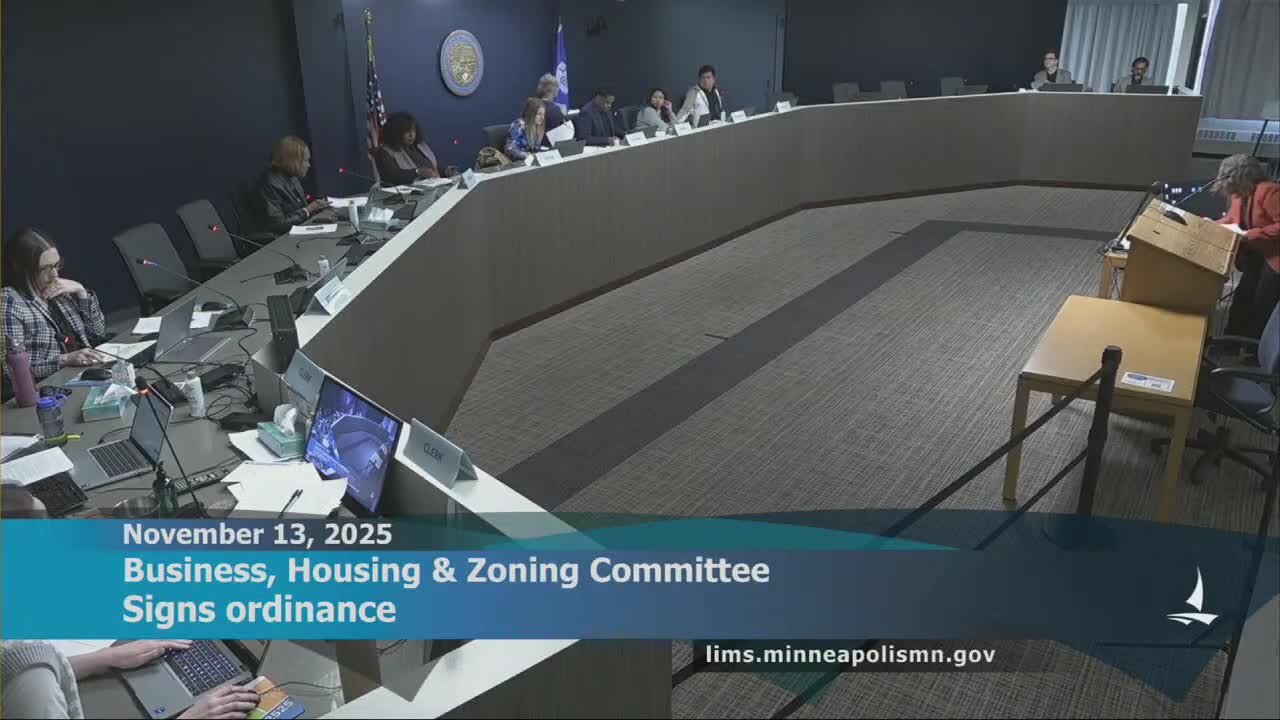Council committee approves sign-code changes and a temporary pause on new billboards
November 14, 2025 | Minneapolis City, Hennepin County, Minnesota
This article was created by AI summarizing key points discussed. AI makes mistakes, so for full details and context, please refer to the video of the full meeting. Please report any errors so we can fix them. Report an error »

The Minneapolis Business, Housing & Zoning Committee voted Nov. 13 to advance a comprehensive amendment to the city's sign code that increases flexibility for on-premises signs and pauses the construction of new off-premises billboards and conversions of static displays to digital while staff develops a new policy framework.
CPED planner Sarah Roman said the changes ease permitting for painted-wall signs, expand allowances for skyway and nonprimary-wall signage, allow limited temporary art and building-wrap signs, and simplify fees. The amendments also carve out new rules for CM3 corridors and would exempt civic, cultural and sports-related off-premises signs from some restrictions.
On billboards, staff recommended a temporary prohibition on new billboards and digital conversions while the city completes a ‘phase 2’ process that could include a legislative request to enable revenue-sharing or larger permit fees — a model used in other cities such as Denver and San Antonio to fund arts and cultural programs. “This pause is intended to be time-limited while we create a new system,” Roman said.
Council member Cashman offered an amendment to allow property owners in the Downtown West Entertainment Billboard District to convert existing static billboards to digital; the committee adopted the amendment on a 5–1 vote and then approved the amended ordinance language unanimously. Vice Chair Chowdhury said he could not support the amendment without clearer data on how many signs could digitize in that limited district and on anticipated impacts.
City staff said they would pursue legislative outreach this winter and conduct additional community engagement and technical analysis before any permanent changes to billboard policy. City attorney staff provided minor recommended wording clarifications that were incorporated into the final motion.
What happens next: The amended sign-code ordinance and associated findings will move to the full council for final consideration. CPED will continue outreach and report back to policy makers on potential revenue-sharing models and a proposed timeline for phase 2.
CPED planner Sarah Roman said the changes ease permitting for painted-wall signs, expand allowances for skyway and nonprimary-wall signage, allow limited temporary art and building-wrap signs, and simplify fees. The amendments also carve out new rules for CM3 corridors and would exempt civic, cultural and sports-related off-premises signs from some restrictions.
On billboards, staff recommended a temporary prohibition on new billboards and digital conversions while the city completes a ‘phase 2’ process that could include a legislative request to enable revenue-sharing or larger permit fees — a model used in other cities such as Denver and San Antonio to fund arts and cultural programs. “This pause is intended to be time-limited while we create a new system,” Roman said.
Council member Cashman offered an amendment to allow property owners in the Downtown West Entertainment Billboard District to convert existing static billboards to digital; the committee adopted the amendment on a 5–1 vote and then approved the amended ordinance language unanimously. Vice Chair Chowdhury said he could not support the amendment without clearer data on how many signs could digitize in that limited district and on anticipated impacts.
City staff said they would pursue legislative outreach this winter and conduct additional community engagement and technical analysis before any permanent changes to billboard policy. City attorney staff provided minor recommended wording clarifications that were incorporated into the final motion.
What happens next: The amended sign-code ordinance and associated findings will move to the full council for final consideration. CPED will continue outreach and report back to policy makers on potential revenue-sharing models and a proposed timeline for phase 2.
View full meeting
This article is based on a recent meeting—watch the full video and explore the complete transcript for deeper insights into the discussion.
View full meeting
